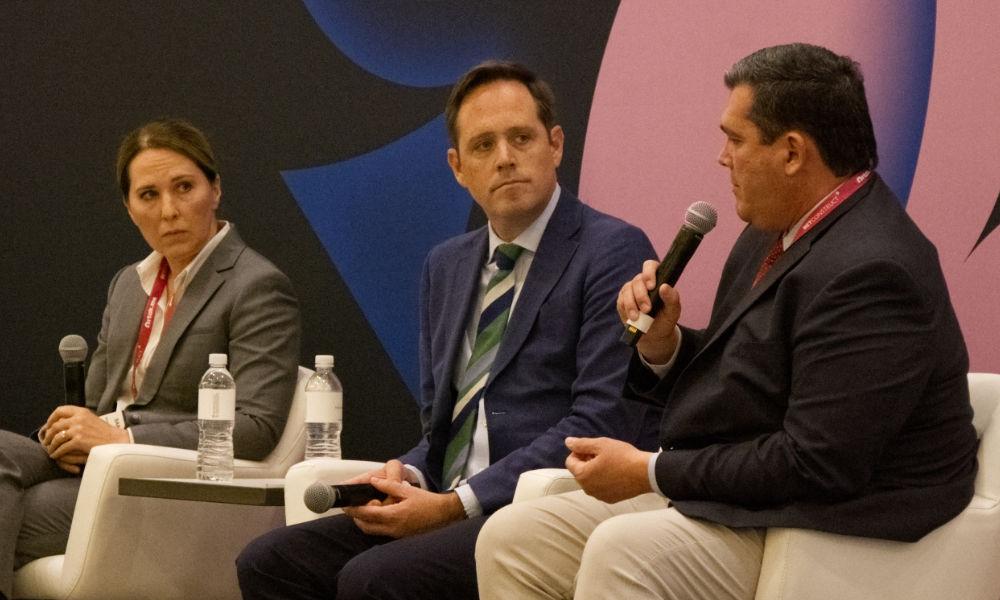The National Indian Gaming Commission’s role in online expansion of tribal gaming and shifts in policy highlighted a session Monday at the Global Gaming Expo.
The session, dealing with navigating tribal gaming regulations in a dynamic federal landscape, was moderated by Brad Bledsoe Downes, general counsel for the Elk Valley Rancheria in California. It featured Sarah Murray, a gaming attorney with Brownstein, Hyatt Farber Schreck and former attorney with the Bureau of Indian Affairs; Sequoyah Simermeyer, vice president of strategic partnerships at FanDuel and former chair of the National Indian Gaming Commission; and Michael Hoenig, associate general counsel for the Yuhaaviatam of San Manuel Nation in California and former general counsel of the NIGC.
“It’s important to remember, and the NIGC had to give a lot of thought to it when I was there, is the NIGC’s role when you have part of the gaming off Indian lands where the (Indian Gaming Regulatory Act) doesn’t apply,” Hoenig said. “The short answer is the NIGC has all the authority and jurisdiction on Indian lands for all of those aspects of the games.”
The management contracts still have to be approved by the agency and if it’s Class II, all the internal controls and technical standards still apply, Hoenig said. “Recently, the Department of Interior updated some of the compacting regulations, so tribes and states can work out jurisdictional issues when talking about off of Indian lands.”
Murray said the NIGC should continue to further clarify its role, with agreements for statewide mobile gaming that are potentially non-management contracts and whether those need their review.
“That’s a continual question that has been posed to me by my clients and others,” Murray said. “There’s still confusion in the industry and among tribes about the NIGC’s authority over this activity. Do we bifurcate our operations if servers are located outside of Indian lands, but the activity is crossing onto Indian land? That clarification could still be improved.”
It isn’t known what the Trump Administration will change from policies approved during the Biden administration.
Murray said the cleanest legal theory is to have a separation between what’s happening on and off Indian lands, but that might not be the most desirable outcome for gaming operations.
“Most gaming operations would want to have a seamless experience for users that are on and off reservation,” Murray said. “It depends on the state and the state laws related to gaming. As we’ve seen in Florida, gaming outside of Indian lands is limited and expansion can only happen through a voter referendum. However, Florida has a law that interprets a wager to be located at the place a server is located. That’s why we can have statewide mobile wagering from Indian lands.
“Other states, like New York and New Jersey, have similar place-of-wager laws and those cases can be pretty straightforward on how you can achieve on reservation gaming that is available statewide,” Murray said. “In states like Arizona, the law is very clear that Indian lands must be excluded from statewide mobile sports betting and geofenced. You can have on-reservation only by mobile and outside-of-Indian-lands mobile.”
Hoenig said the Florida compact between the Seminole Tribe and state is a good one.
“The Department of Interior sent a letter explaining the theory that this particular model in Florida worked, because the state and tribe negotiated the scope of the state’s jurisdiction when it comes to off-Indian-lands gaming,” Hoenig said. “That was an interesting and well-done solution. The letter also pointed out that this works great for Florida, but other states may have other ways of doing it. The Department of Interior recognized there’s no one particular way this can be done. Tribes and states can be creative in how they get there.”
When the Department of Interior updated its compacting regulations, it put in language that off-Indian-landa gaming can be included in a compact, Hoenig said.
Simermeyer said because there are so many different approaches, there’s harmony in how tribes are interpreting it.



